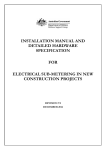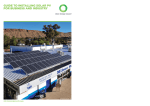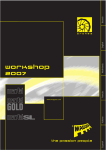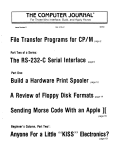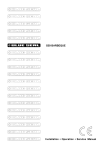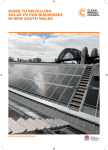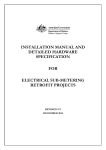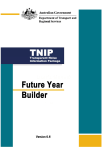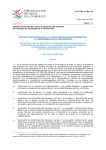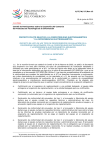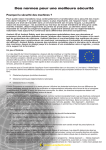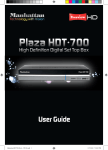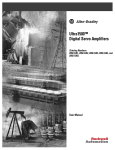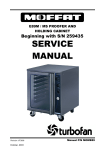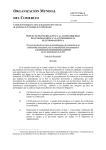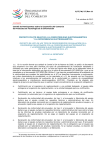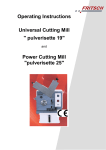Download Electromagnetic Compatibility
Transcript
Electromagnetic Compatibility Information for suppliers of electrical and electronic products in Australia and New Zealand July 2003 © Australian Communications Authority 2003 This work is copyright. Apart from any use as permitted under the Copyright Act 1968 , no part may be produced by any process without prior written permission from the Australian Communications Authority. Requests and enquiries concerning reproduction and rights should be addressed to: Introduction Manager Communications Australian Communications Authority PO Box 13112 Law Courts Melbourne VIC 8010 Effective radiocommunications contributes significantly to the operations of industr y, commerce, safety-of-life organisations and the well-being of the community. To deal with the problem of electromagnetic interference to radiocommunications,the Australian Communications Authority (ACA) and the Radio Spectrum Management Group (RSM) of the New Zealand Ministry of Economic Development have introduced the trans-Tasman electromagnetic compatibility (EMC) regulatory arrangements. The arrangements aim to protect the radiofrequency spectrum by introducing technical limits for emissions from electrical and electronic products. The regulations are designed to minimise electromagnetic emissions from electrical or electronic products that could cause harmful interference to radiocommunications systems. This is becoming increasingly important with the rapid growth in the use of electronic systems and digital technology in commercial and domestic environments. All products that come under the standards ar e subject to compliance and must be labelled appropriately. It is important that manufacturers and importers understand what is required for compliance. Accountability for compliance with the EMC regulatory arrangements lies with Australian and New Zealand suppliers and they must tak e responsibility for the products they place on the market. The harmonised arrangements are an outcome of the Trans-Tasman Mutual Recognition Arrangement (TTMRA) which is an inter-Government arrangement between Australia and New Zealand. Its objective is to assist in the movement of goods and services between both countries. Through mutual recognition and alignment of product standards,the arrangements deliver greater flexibility and lower business compliance costs to exporters on both sides of the Tasman Sea. This booklet outlines requirements for suppliers of electrical and electronic products under the harmonised arrangements. The trans-Tasman EMC arrangements consist of a set of technical standards and common regulator y processes for products supplied to the Australian and New Zealand markets. The EMC arrangements have the same legal standing in Australia and New Zealand and compliance in one country will be recognised in the other. Electromagnetic Compatibility 3 Contents EMC standards Compliance through testing Are you affected? Are you affected? . . . . . . . . . . . . . . . . . . . . . . . .5 What is an agency agreement? . . . . . . . . . . . . . .5 What standards apply? . . . . . . . . . . . . . . . . . . . . 5 How do I arrange to have my product tested? .12 Can I use an overseas test report? . . . . . . . . . .12 Do I need the original test report? . . . . . . . . . .12 What products require accredited testing? . . . .12 The EMC regulations apply to suppliers of a wide range of electrical and electronic products in Australia and New Zealand. Compliance arrangements Compliance through TCF What are the EMC compliance arrangements? . . . . . . . . . . . . . . . . . .6 How do I know which le vel applies to my product? . . . . . . . . . . . . . . . . . . . .6 What are the requirements of each le vel? . . . . . .6 What is a Declaration of Conformity? . . . . . . . . .7 Does every product require a new Declaration of Conformity? . . . . . . . . . . . . .7 What is a TCF? . . . . . . . . . . . . . . . . . . . . . . . . .13 What does the competent body provide? . . . .13 What should a TCF contain? . . . . . . . . . . . . . . .13 Introduction . . . . . . . . . . . . . . . . . . . . . . . . .3 EMC standards Exemptions Are there any exemptions? . . . . . . . . . . . . . . . . .8 Compliance records What are compliance records? . . . . . . . . . . . . . .9 Can I store my compliance records electronically? . . . . . . . . . . . . . . . . . . . . .9 Where do I keep the compliance records? . . . . . 9 How long should I keep the compliance records? . . . . . . . . . . . . . . . . . . . . . .9 Labelling requirements What is the purpose of the label? . . . . . . . . . . .10 Should my products be labelled? . . . . . . . . . . . .10 What are the acceptable methods for supplier identification? . . . . . . . . . . . . . . . . .10 What if my product needs the A-Tick for telecommunications standards? . . . . . . . . . . . . .11 What is the Regulatory Compliance Mark? . . . .11 4 Electromagnetic Compatibility Enforcement Will the ACA or RSM inspect the compliance records? . . . . . . . . . . . . . . . . . .14 How does the ACA or RSM decide who is to be audited? . . . . . . . . . . . . . . . . . . . .14 What penalties apply? . . . . . . . . . . . . . . . . . . . .14 Who do I contact if I have further enquiries? . . . . . . . . . . . . . . . . . . . . . . .14 Appendixes A:EMC standards concordance . . . . . . . . . . . . .15 B:Standards Australia and Standards New Zealand . . . . . . . . . . . . . . . . . . .18 C:New Zealand and Australian state and territory electrical regulators . . . . . . .19 D:Other regulatory agencies (Australia) . . . . . .20 E:National Association of Testing Authorities,Australia and International Accreditation New Zealand . . . . . . . . . . . . . . . .21 F: ACA regional offices . . . . . . . . . . . . . . . . . . .22 Forms Application to use the C-Tick mark . . . . . . . . .24 Supplier’s Declaration of Conformity . . . . . . . . .26 A supplier is: • an Australian or New Zealand manufacturer who makes products for supply to the Australian or New Zealand market;or • an importer of products intended for supply in Australia or New Zealand;or • the authorised agent, resident in Australia or New Zealand,acting on behalf of a supplier of products to either country. What is an agency agreement? Where an Australian or New Zealand based manufacturer or importer or an overseas manufacturer engages the services of an agent, a written agency agreement should exist between the two parties. The ACA and RSM require that the regulatory compliance arrangements be met by either the manufacturer (or importer) or by the agent acting on their behalf. Agency agreements help to establish a legal framework and outline the rights and responsibilities of the parties involved. A copy of this agreement should be kept with the compliance records. Further information is available on the ACA website (www.aca.gov.au/standards_compliance.htm). What standards apply? All electrical and electronic products that fall within the scope of the mandated standards listed in Appendix A must comply with the EMC regulatory arrangements. The standards listed in Appendix A cover a wide range of products and deal with various technical matters associated with product performance including EMC. The ACA and RSM have only mandated the following EMC aspects of the listed standards: 1. EMC phenomenon of emitted disturbance associated with: • conducted (continuous and intermittent) radiofrequency disturbance • radiated radiofrequency disturbance 2. test procedures and requirements associated with the EMC phenomenon. The ACA and RSM have mandated the standards as ‘in force from time to time’. This means that any changes made to the standards by the relevant standards-making bodies are automatically recognised under the EMC arrangements. However, before any changes become automatically mandator y, transitional arrangements will apply. The transitional arrangements are detailed in Appendix A. The standards can be purchased from Standards Australia or Standards New Zealand—contact details are listed in Appendix B. Immunity standards are not mandatory under the Australian–New Zealand regulatory arrangements. However, manufacturers are encouraged to consider immunity during their product design,especially if planning to export products,as there may be a requirement in overseas countries. Electrical products sold in Australia and New Zealand are also required to comply with electrical safety requirements administered by other regulatory authorities. Appendix C provides contact details of the electrical regulators in New Zealand and in Australian States and Territories. Electromagnetic Compatibility 5 Compliance arrangements What are the EMC compliance arrangements? To ensure compliance with the EMC regulator y arrangements,suppliers must satisfy four basic requirements. They must: • establish sound technical grounds for product compliance; • make and hold a Declaration of Conformity; • prepare and keep compliance records;and • label the product as directed. Under the EMC regulatory arrangements,before a product can be first supplied to the Australian or New Zealand market,the supplier must register an application with the ACA or RSM to use the C-Tick label. One application only is required,as the label and associated identification from one country will be recognised in the other. A copy of the form is inside the back cover of this booklet and can also be downloaded from the ACA website at www.aca.gov.au/standards_compliance.htm or the RSM website at www.med.govt.nz/rsm/ standards/index.html. All other documents,the Declaration of Conformity and the supporting evidence, should be made available by the supplier for audit purposes on request in writing from either the ACA or RSM. Once these basic requirements have been satisfied, a product may be supplied in Australia or New Zealand without further approval by the ACA or RSM. The EMC scheme defines three levels of evidence for demonstrating compliance. These levels are based on the risk of interference that may be expected from the product. How do I know which level applies to my product? Le vel 1 applies to products whose interfering emissions would have a low impact on devices using the radiofrequency spectrum. This level covers 6 Electromagnetic Compatibility products that only contain: • manually operated switches or simple relays; • brushless squirrel cage induction motors; • conventional AC/AC transformers;or • resistive elements. For example, an electronic transformer, a lighting ballast or electronic lighting ballast are not low risk devices. Le vel 2 applies to products whose interfering emissions would have a higher impact on devices using the radiofrequency spectrum. Examples of these products are: • a microprocessor or other clocked digital device; • a commutator or slip ring motor ; • arc welding equipment;or • switched mode power supplies,lighting dimmers and motor speed controllers. Le vel 3 applies to products whose interfering emissions have the highest risk of serious impact on devices using the radiofrequency spectrum. This level covers products in the industrial scientific and medical group 2 (CISPR 11). EMC compliance requirements for telecommunications terminal equipment under information technology (CISPR 22) will change from compliance level 3 to compliance level 2 from 7 November 2003. What are the requirements of each level? Le vel 1 (voluntary) For this level,the Australian or New Zealand supplier may: • hold a completed Declaration of Conformity;and • hold a product description. For Level 1 products,the requirement to obtain the above documents and label with the C-Tick compliance mark (see under Labelling requirements below) is voluntary. However, if suppliers choose to use the C-Tick mark on Le vel 1 products,they must comply with the arrangements by holding a Declaration of Conformity and a description of the product. The voluntary nature of the arrangements does not exclude the products from having to meet the relevant EMC standard. Products must still meet the relevant EMC standard regardless of whether they are labelled. Where changes to a basic compliant model are not technically significant (for example, the changes are cosmetic only or do not alter the radiofrequency emission characteristics established for the basic model),then the supplier may presume compliance. Le vel 2 For this level,the Australian or New Zealand supplier must ensure the product complies with an applicable standard and hold compliance records containing: • a completed Declaration of Conformity; • a product description;and • a test report or technical construction file (TCF). In these cases the supplier may place variants of a basic device on the market under one Declaration of Conformity. The compliance records must include a signed statement that identifies the variants,describes the changes made to the basic model and the rationale for marketing the device and variants under a single Declaration of Conformity. Le vel 3 For this level,the Australian or New Zealand supplier must ensure the product complies with an applicable standard and hold compliance records containing: • a completed Declaration of Conformity; • a product description;and • an accredited test report or TCF. Where a supplier is in any doubt as to the likely impact of proposed modifications to a device , the supplier should have the new model tested or establish a TCF for the product. What is a Declaration of Conformity? The Declaration of Conformity is the document signed by the Australian supplier or overseas manufacturer to certify that the product meets applicable standards. It must be signed by a person who holds a senior position in the company or organisation. The signatory should have sighted the evidence that supports the declaration and be satisfied of the grounds for compliance. The signed declaration must be made available if requested b y the ACA or RSM. Examples of products marketed with a number of variants include lighting or personal computers,which are sold in various configurations. All products under a single declaration must be identical to the basic device in terms of EMC. The declaration must contain the following information: • variants identification and their similarities; • description of changes made to the basic model; and • explanation of rationale for marketing the products under one declaration. A copy of the Declaration of Conformity is inside the back cover of this booklet and can also be downloaded from either the ACA website www.aca.gov.au/standards_compliance.htm or the RSM website (www.med.govt.nz/rsm/standards/ index.html). Does every product require a new Declaration of Conformity? Each new model or product requires a Declaration of Conformity. Electromagnetic Compatibility 7 Exemptions Compliance records Are there any exemptions? • In Australia , the EMC regulations do not apply in the following circumstances. • Test or educational electronic equipment—any product designed or adapted for the purpose of conducting any test,measurement or study of electromagnetic phenomena in an educational,training or research establishment. • A fixed installation comprising a combination of types of devices,components and hardware that are assembled and installed in such a way that the combination cannot be moved without a part of the combination being at least partially disassembled. • A prototype or product to be used for exhibition and demonstration purposes, for example, at trade fairs. • Spare parts—a component or combination of components intended for use in replacing parts of electrical or electronic products. • Second-hand products,previously supplied either in Australia or New Zealand,but not including modified products. • Devices that have a power consumption which does not exceed six nanowatts. • Radiocommunications products—these are intentional radiators and are generally excluded from the EMC regulations. These products are covered by a different set of standards and compliance arrangements administered by the ACA. Some radiocommunications products have other electronic functions,and may be included on this basis. If there is any doubt contact your nearest ACA office—see Appendix F. • Devices that are used solely for law enforcement activities by the following criminal law-enforcement agencies: – the Australian Federal Police; – a police force or service of a state or territory; – the National Crime Authority; – the New South Wales Crime Commission; – the Independent Commission Against Corruption of New South Wales; – the Criminal Justice Commission of Queensland; – a prescribed authority established by or under a law of the Commonwealth,a state or a territory;or – a body or organisation responsible to the Australasian Police Ministers’ Council for the facilitation of national law enforcement support. • 8 Electromagnetic Compatibility • • Civil Aviation Safety Authority—avionics and aviation ground facilities. Department of Defence—devices used by the Australian Defence Force for military operations. Department of Transport and Regional Services— road-registrable vehicles. Therapeutic Goods Administration—devices that fall within the jurisdiction of the Therapeutic Goods Act. Suppliers of products regulated by these agencies should ensure that they are familiar with existing or proposed regulations for dealing with EMC . Appendix D of this booklet provides contact details for these agencies. In New Zealand , the administrative components of the EMC regulations do not apply in the following circumstances. • A product with a power consumption that does not exceed six nanowatts. • A spare part intended for use in replacing parts of a product. • A vehicle that is registered or capable of being registered for use on a public road. • Military equipment or weapons systems of the New Zealand Defence Force. • Military equipment or weapons systems of the defence force of another country operating in cooperation with the New Zealand Defence Force. • For products under compliance Level 2: – a prototype for demonstration purposes; – a fixed installation; – a part that will only perform its function when incorporated in a finished product; – products supplied in a total quantity of less than 10 per year; and – battery-powered products. • Radiocommunications products—these are intentional radiators and are generally excluded from the EMC regulations. They are covered by a different set of standards and compliance arrangements administered by the RSM (some radiocommunications products have other electronic functions and may be included on this basis,but if there is any doubt contact RSM). What are compliance records? Compliance records are a collection of documents assembled by the supplier to support the declaration that the product placed on the Australian or New Zealand market complies with the relevant standard. These records are often referred to as the ‘compliance folder’. The documents included will depend on the compliance level. They may include some or all of the following: • test reports or TCF; • a description of the marketed product that positively identifies it (for example, brand name or model number),possibly including a photograph and/or block diagram; • drawings and/or circuit diagram(s);and • a signed Declaration of Conformity. Can I store my compliance records electronically? Yes,providing a hard copy, in English,is produced for inspection at audit. Where do I keep the compliance records? All records may be held either in Australia,New Zealand or overseas once they have been examined by the supplier to establish compliance . However, the records must be made available to the ACA or RSM, for audit or investigation purposes,within 10 working days of written advice being issued by the ACA or RSM. At that time the compliance records must be available for inspection at the Australian or New Zealand business address nominated on the C-Tick application form. How long should I keep the compliance records? The records must be kept for five (5) years after the product ceases to be supplied in Australia or New Zealand. What is a product description? A product description can be any one of the following: ü ü ü ü ü ü ü ü a clear photograph of the product block diagram circuit diagram promotional material service manual operating manual or user guide a list of modular pieces or accessories packaged with the product installation manual. A technical description can be: ü ü performance specifications other information such as PCB revision, software revision or hardware revision. Electromagnetic Compatibility 9 Labelling requirements What is the purpose of the label? The label indicates that the product complies with the applicable standard and establishes a traceable link between a product and the supplier responsible for placing it on the Australian or New Zealand market. The use of the C-Tick cannot be transferred to another party without the prior approval of the ACA or RSM. Should my products be labelled? Unless a product is covered by compliance Level 1, which is voluntary, a product covered by the EMC regulatory arrangements must be labelled before it can be supplied in Australia or New Zealand. The label consists of a C-Tick mark and a unique supplier identification. The C-Tick mark is only allowed to be placed on products that comply with EMC standards. The C-Tick mark is a certification trademark registered to the ACA in Australia under the Trade Marks Act 1995and to RSM in New Zealand under section 47 of the NZ Trade Marks Act. The mark is only to be used in accordance with conditions laid down by the ACA and RSM. A company or person wishing to use the C-Tick mark must make a written application to the ACA or RSM. The application form is available inside the back cover of this booklet. There is no registration fee. Bromides and an electronic version of the C-Tick mark are available, for a nominal fee , from Standards Australia sales offices or RSM. Compliance marks can also be downloaded from either the ACA website (www.aca.gov.au/standards_compliance.htm) or the RSM website (www.med.govt.nz/rsm/ standards/index.html). Authority to use the C-Tick mark will only be issued to an Australian or New Zealand based supplier. 10 Electromagnetic Compatibility All products that fall under compliance Le vels 2 and 3 must be labelled. If a manufacturer or importer chooses to label Level 1 products,the above labelling arrangements would also apply. What are the acceptable methods for supplier identification? The compliance label must include the identification of the manufacturer, importer or their agent. The options for this identification in Australia are: • a business name and address in Australia; • a business name registered on the national business register; • a personal name and address in Australia of the place of business; • an Australian company number (ACN); • an Australian registered body number (ARBN); • an Australian business number (ABN); • an Australian registered trademark;or • the supplier code number issued by the ACA (on application). The options in New Zealand are: • the registered name and address of the licensee; • a New Zealand company number of the licensee; • a New Zealand registered trademark of the licensee; • a registered Goods and Services Tax (GST) number; or • the supplier code number issued by the RSM (on application). Note:If the trademark option is to be used,the supplier must hold a copy of either the Australian or New Zealand trademark registration certificate including a true representation of the trademark with their compliance records. Label requirements The mark: to be used exactly as shown on the ACA or RSM websites. No variations are permitted. Location: the mark and supplier identification should be a permanent feature placed on the external surface of the product as close as practical to the model identification. If it is not practical to attach a label to the external surface of a device, due to its size or physical natur e, a label may be attached in the following order : • to the outer surface of the packaging;or if impractical • to the instructions for use;or if impractical • to the guarantee or certificates. The supplier must also apply in writing to the ACA or RSM explaining why the label can not be attached to the surface of the device , advising of the intended alternative method to be used. If the explanation is acceptable, the ACA or RSM will provide written approval,which must be kept with the compliance records. Method of marking: the label shall be durably applied by any suitable means such as printing, painting,moulding,etching or engraving. Scale: the mark shall be legible and visible to the unaided eye, no smaller than three millimetres in diameter, and the supplier identification characters must be no less than one millimetre in height. Colour : the label may be reproduced in any colour provided that visibility is assured through either contrast with the background colour or marking in relief (for example, moulding or engraving). The product may be labelled at any point before being supplied to the Australian or New Zealand market. The ACA and RSM recognise that it will be more cost-effective for many imported products if they are labelled at the time of manufacture rather than to apply the label at the time of marketing and distribution. In addition,the label may be placed on promotional material associated with the product. What if my product needs the A-Tick for telecommunications standards? If your product is subject to the Australian Telecommunications Labelling Notice and must also meet an EMC standard,(for example, CISPR 22 for information technology) the A-Tick mark will indicate compliance with both EMC and telecommunications requirements in Australia,but only with EMC requirements in New Zealand. What is the Regulator y Compliance Mark? The Regulatory Compliance Mark (RCM) is a trademark owned by Australian and New Zealand regulators. It is an alternative mark to the C-Tick for signifying EMC compliance. Suppliers from both countries who intend to use the RCM should register with Standards Australia in accordance with AS/NZS 4417.1 and complete the application form in AS/NZS 4417.3 to notify the ACA. The RCM is not an alternative mark to the A-Tick telecommunications compliance mark. Electromagnetic Compatibility 11 Compliance through testing How do I arrange to have my product tested? A supplier may keep compliance records and sign a Declaration of Conformity without using a test report from an accredited test laboratory for products that fall under compliance Le vel 2. The test report must show: • the tests conducted; • the results of the tests,including test data;and • whether the results of the tests show that the product meets the standard. The supplier accepts total responsibility for product conformity and needs to make a commercial decision on the level of testing required. When making the decision,the supplier should keep in mind the interference potential of the product. Where a supplier chooses to use non-accredited testing,including in-house or self-testing,to support their Declaration of Conformity, the ACA and RSM reserve the right to ask for more evidence of conformity, if considered necessary. Can I use an overseas test report? A test report from an overseas test laboratory is acceptable where the product has been tested to the relevant standard listed in Appendix A. Test reports from overseas laboratories must be written in English. Do I need the original test report? The supplier does not have to hold the original of the test report. A clear copy of the original report is acceptable. Compliance through TCF There are a number of overseas laboratories that have been accredited through a Mutual Recognition Agreement (MRA) with either NATA or IANZ. Suppliers should contact NATA or IANZ for current details of MRA partners or accredited laboratories. The ACA and RSM suggest that the supplier check the accreditation of the laboratory when arranging for the testing of a product,as not all laboratories hold accreditation for all standards. Although nonaccredited reports may be acceptable in most situations,they do not hold the same level of confidence as an accredited report. What is a TCF? A reproduction of the original report that has been scanned and stored electronically may also be held, but must be available on request in hard copy at the time of audit. What products require accredited testing? Compliance Level 3 products are required to be tested by an accredited test laboratory or a competent body. Level 3 covers equipment under group 2 of the industrial scientific and medical standard (CISPR 11). It is the ACA’s and RSM’s view that a test report from an accredited test laboratory constitutes a high confidence and low risk approach to compliance . There are a number of companies that ha ve been accredited by the National Association of Testing Authorities (NATA) in Australia and International Accreditation New Zealand (IANZ), for various EMC standards. Contact details for the accredited test laboratories are available from the NATA website (www.nata.asn.au) or the IANZ website (www.ianz.govt.nz). What does the competent body provide? The competent body confirms claims made by a supplier in the draft TCF. Once the assessment is completed,the competent body will issue a technical report verifying the claims made by the supplier, which will then form part of the compliance records. The report made by the competent body does not replace the supplier’s responsibility to ensure that the data in the draft TCF is correct. The technical construction file (TCF) is an alternative route to testing for suppliers to demonstrate compliance for Levels 2 or 3. If a competent body finds that the claims of the supplier for conformity of a product to the standards cannot be verified,the competent body must advise the applicant in writing of the reasons for its decision. To use the TCF route, suppliers must apply to a competent body for a technical report. A TCF can be particularly useful where: • testing is impractical because of the physical characteristics of the product,or its location; • products are marketed as a number of variants;or • a supplier holds relevant technical information from a competent body. Competent bodies cannot issue a technical repor t against an application: • where the application is not in writing;and • where an applicant for a technical report has not provided information that is relevant to the assessment of the draft TCF. The TCF is prepared in two parts. The first part is prepared by the supplier and should contain sufficient information for a competent body to issue a technical assessment of the product. The information may include a technical description of the product, claims by the supplier for product conformity and supporting evidence. This information is submitted to a competent body with a statement from the supplier declaring that there is no outstanding application to another competent body in respect of the product. Contact details of accredited competent bodies ar e available from the NATA website (www.nata.asn.au). The ACA and RSM will use NATA or IANZ accredited testing as the benchmark and,in the event of product conformity being called into question,the ACA and RSM will accept NATA or IANZ test data as final in any determination of whether the product complies. 12 Electromagnetic Compatibility Electromagnetic Compatibility 13 Appendix A: Enforcement What should a TCF contain? A TCF should contain: • a signed statement by the competent body; • an adequate description of the product to be marketed under the TCF; • a technical rationale for the use of the TCF route; • a statement of the steps taken to manage the emissions and/or susceptibility characteristics of the product,including reference to standards applied in part or in full; • a technical description of the product; • all technical reports relevant to the product;and • all reports issued by the competent body. Will the ACA or RSM inspect the compliance records? Although the EMC regulations are based on industr y self-regulation,the ACA and RSM back this up with an audit program in their respective jurisdictions. An enforcement program is a critical way of managing risk and is a commitment of the ACA and RSM to suppor t responsible suppliers. How does the ACA or RSM decide who is to be audited? Suppliers are selected for audit in se veral ways. These include: • a random selection from the database; • receipt of a written complaint; • products identified at retail outlets; • products identified through advertising material;or • interference to communications. When a supplier is selected for audit,the ACA or RSM will provide written notice to the supplier a minimum of 10 working days before the proposed date of the audit. The auditor will examine the documents that form the compliance records. When the auditor is satisfied that all the documentation and reports are cor rect the supplier will be given a Satisfactor y Audit Statement. EMC standards concordance This statement does not indicate compliance of the item(s). It only means that the compliance records were complete. The ACA and RSM have mandated the following EMC aspects of the standards listed below: Where an auditor requires further evidence of product conformity, additional information will be requested. This may range from producing additional documentation,to the submission of three randomly selected samples of the product for evaluation by an accredited laboratory nominated by the ACA or RSM. Samples for testing will only be required wher e compliance of the product comes into question. 1. EMC phenomenon of emitted disturbance associated with: • conducted (continuous and intermittent) radiofrequency disturbance; • radiated radiofrequency disturbance. 2. Test procedures and requirements associated with the above EMC phenomenon. Offences include: • using the C-Tick mark without authorisation; • supplying unlabelled products; • supplying or labelling non-compliant products; • making a false declaration;or • failure to establish and maintain compliance records. Electromagnetic Compatibility Transitional arrangements for amendments to the standards are: • two (2) years for IEC, CISPR, AS/NZS standards at the time of publication;and • transitional period as published in the Official Journal of the European Unionfor EN standards. What penalties apply? There are a range of penalties including: • prohibiting the supply of products until an interference problem is corrected;or • seizure and forfeiture of stock in Australia or compulsory recall in New Zealand;or • penalties payable in lieu of prosecution in Australia or infringement offence and fine in New Zealand;or • prosecution;or • fines. Who do I contact for more information? For more information in Australia,contact your nearest ACA office (Appendix F) or the ACA's Radiocommunications Standards Team on telephone (02) 6219 5451 facsimile (02) 6219 5288 or email:[email protected]. To contact RSM in New Zealand,telephone 0508 RSM INFO or 0508 776 463,facsimile 09 916 4561 (telephone +64 3 962 2602 or facsimile +64 9 916 4561 from outside NZ) or email:[email protected] New Zealand. The transitional arrangement is the time period where the ACA and RSM will recognise conformity to either the earlier or later version of the same standard for products supplied to the market. When the transitional period expires,the ACA and RSM will only recognise the later version of a standard for compliance purposes with the EMC scheme . Product European International ISM equipment EN 55011 CISPR 11 AS/NZS CISPR 11 CISPR 12 AS/NZS CISPR 12 Spark ignition engines If there are any changes to your contact details,please inform your nearest ACA or RSM office so that your details can be updated on the supplier database. 14 Other EMC phenomenon such as radiofrequency immunity, electrostatic discharge (ESD), harmonics,flicker and voltage fluctuations are not mandatory. AS/NZS TV receivers and audio equipment EN 55013 CISPR 13 AS/NZS CISPR 13 Electrical motor-operated & thermal appliances,electric tools & similar apparatus EN 55014-1 CISPR 14-1 AS/NZS CISPR 14 Electrical lighting and similar equipment EN 55015 CISPR 15 AS/NZS CISPR 15 Information technology EN 55022 CISPR 22 AS/NZS CISPR 22 Generic (residential,commercial and light industry) EN 50081.1 IEC 61000-6-3 4251.1 Generic (industrial environments) IEC 61000-6-4 4251.2 EN 50081-2 Arc welding equipment EN 50199 Signalling on low-voltage electrical installations EN 50065-1 IEC 61000-3-8 Uninterruptible power systems (UPS) EN 50091-2 IEC 62040-2 Electronic taximeters EN 50148 Control circuit devices and switching elements proximity sensors,direct current interface for proximity sensors and switching amplifiers EN 50227 Measuring relays and protection equipment EN 50263 Electrical apparatus for the detection and measurement of combustible gases,toxic gases or oxygen EN 50270 Audio, video, audiovisual and entertainment lighting control apparatus for professional use EN 55103-1 3652 AS 62040.2 Electromagnetic Compatibility 15 Product European International Sewing machines EN 60204-31 IEC 60204-31 AS/NZS Product European International Low voltage switchgear and controlgear (AC semiconductor controllers and contactors for non-motor loads) EN 60947-4-3 IEC 60947-4-3 Low voltage switchgear and controlgear (control circuit devices and switching elements) EN 60947-5-1 IEC 60947-5-1 Low voltage switchgear and controlgear (proximity switches) EN 60947-5-2 IEC 60947-5-2 Low voltage switchgear and controlgear (proximity devices with defined behaviour under fault conditions) EN 60947-5-3 IEC 60947-5-3 Low voltage switchgear and controlgear (DC interface for proximity sensors and switching amplifiers) EN 60947-5-6 IEC 60947-5-6 Low voltage switchgear and controlgear (automatic transfer switching equipment) EN 60947-6-1 IEC 60947-6-1 Low voltage switchgear and controlgear assemblies EN 60439-1 IEC 60439-1 Switches for household and similar fixed-electrical installations (electronic switches) EN 60669-2-1 IEC 60669-2-1 Switches for household and similar fixed electrical installations (remote control switches) EN 60669-2-2 IEC 60669-2-2 Switches for household and similar fixed electrical installations (time-delay switches) EN 60669-2-3 IEC 60669-2-3 Alternating current static watt hour meters for active energy (classes 0,2 S and 0,5 S) EN 60687 IEC 60687 Automatic electrical controls for household and similar use (general requirements) EN 60730-1 IEC 60730-1 Automatic electrical controls for household and similar use (automatic electrical burner control systems) EN 60730-2-5 IEC 60730-2-5 IEC 60947-6-2 EN 60730-2-6 IEC 60730-2-6 Low voltage switchgear and controlgear (control and protective switching devices) EN 60947-6-2 Automatic electrical controls for household and similar use (automatic electrical pressure sensing controls) EN 61008-1 IEC 61008-1 Automatic electrical controls for household and similar use (timers and time switches) EN 60730-2-7 IEC 60730-2-7 Residual current operated circuit-breakers without integral overcurrent protection for household and similar uses IEC 61036 EN 60730-2-8 IEC 60730-2-8 Alternating current static watt-hour meters for active energy (classes 1 and 2) EN 61036 Automatic electrical controls for household and similar use (electrically operated water valves) Electricity metering – tariff and load control EN 61037 IEC 61037 Automatic electrical controls for household and similar use (temperature sensing controls) EN 60730-2-9 IEC 60730-2-9 Time switches for tariff and load control EN 61038 IEC 61038 Automatic electrical controls for household and similar use (energy regulators) EN 60730-2-11 IEC 60730-2-11 Alternating current static var-hour meters for reactive energy (classes 2 and 3) EN 61268 IEC 61268 Automatic electrical controls for household and similar use (humidity sensing controls) EN 60730-2-13 IEC 60730-2-13 Electrical equipment for measurement,control and laboratory use EN 61326 IEC 61326 Automatic electrical controls for household and similar use (electric actuators) EN 60730-2-14 IEC 60730-2-14 Residual current-operated protective devices (RCDs) for household and similar use EN 61543 IEC 61543 Automatic electrical controls for household and similar use (automatic electrical water and air flow sensing controls) EN 60730-2-18 IEC 60730-2-18 Telecontrol equipment and systems EN 60870-2-1 IEC 60870-2-1 Maritime navigation equipment EN 60945 IEC 60945 Low voltage switchgear and controlgear EN 60947-1 IEC 60947-1 Low voltage switchgear and controlgear (circuit-breakers) EN 60947-2 IEC 60947-2 Low voltage switchgear and controlgear (switches,disconnectors, switch disconnectors and fuse combination units) EN 60947-3 IEC 60947-3 Low voltage switchgear and controlgear (contactors and motor starters – electromechanical contactors and motor-starters) EN 60947-4-1 IEC 60947-4-1 Low voltage switchgear and controlgear EN 60947-4-2 (AC semiconductor motor controllers and starters) 16 Electromagnetic Compatibility IEC 60947-4-2 Adjustable speed electrical power drive systems EN 61800-3 IEC 61800-3 Specified time relays for industrial use EN 61812-1 IEC 61812-1 Telecommunication network equipment EN 300386 AS/NZS 1. The time of publication of International Electrotechnical Commission (IEC) and International Special Committee on Radio Interference (CISPR) standards can be obtained from the IEC website at: www.iec.ch/webstore. Publication information on Australian/New Zealand (AS/NZS) standards is available on the Standards Australia website:www.standards.org.au. 2. Transitional arrangements published in the Official Journal of the European Union are available on the website http://europa.eu.int/comm/enterprise/newapproach/standardization/harmstds/reflist.html. 3. The AS/NZS CISPR 11 standard for ISM contains restrictions and additional frequencies designated by Australia and New Zealand for use as fundamental ISM frequencies, for example at 918–926 MHz. Code of Practice The ACA and the Australian Electrical and Electronic Manufacturers Association (AEEMA) have developed a Code of Practice for Electromagnetic Compatibility of Industrial Electrical Equipment. Industry signatories to the code are committed to make available instructions to minimise radiofrequency emissions from their equipment. The code is on the AEEMA website at www.aeema.asn.au or the ACA website at www.aca.gov.au/stds_compliance/ electromagnetic_compatibility/emc.htm. Electromagnetic Compatibility 17 Appendix B: Appendix C: Standards Australia and Standards New Zealand New Zealand and Australian state and territory electrical regulators All the applicable standards for the EMC arrangements can be obtained from Standards Australia or Standards New Zealand. Contact details are listed below. Standards Australia website: www.standards.com.au Standards New Zealand website: www.standards.co.nz Australian Capital Territory Shop 5,Gallery Level The Boulevard,City Walk CANBERRA ACT 2601 Telephone:(02) 6249 8990 Facsimile:(02) 6249 8989 New South Wales Head Administration Office 286 Sussex Street SYDNEY NSW 2000 (GPO Box 5420 SYDNEY NSW 2001) Telephone:1300 654 646 or (02) 8206 6000 Facsimile:1300 654 949 or (02) 8206 6001 Website:www.standards.com.au c/- Newcastle and Hunter Business Chamber, 475 Hunter Street NEWCASTLE NSW 2300 Telephone:(02) 4927 0499 Facsimile:(02) 4927 8721 18 Electromagnetic Compatibility Northern Territory Western Australia (Sales Agency) c/- Territory Construction Association Lot 1450 Winnellie Road, WINNELLIE NT 0821 Telephone:(08) 8922 9666 Facsimile:(08) 8922 9600 165 Adelaide Terrace, EAST PERTH WA 6004 Telephone:(08) 9221 6700 Facsimile:(08) 9221 6194 Queensland 232 St Pauls Terrace FORTITUDE VALLEY QLD 4006 Telephone:(07) 3216 1355 Facsimile:(07) 3216 0277 South Australia 63 Greenhill Road WAYVILLE SA 5034 Telephone:(08) 8373 4140 Facsimile:(08) 8373 4124 Tasmania 10 Barrack Street, HOBART TAS 7000 Telephone:(03) 6224 2380 Facsimile:(03) 6224 4185 Victoria 19-25 Raglan Street SOUTH MELBOURNE VIC 3205 Telephone:(03) 9693 3500 Facsimile:(03) 9696 1319 Standards New Zealand 155 The Terrace Private Bag 2439 WELLINGTON Telephone:(04) 498 5990 Facsimile:(04) 498 5994 Website:www.standards.co.nz Besides EMC, products often have to meet other requirements such as electrical safety. Contact details for electrical safety requirements are listed below. New Zealand Principal Technical Advisor Energy Safety Service Ministry of Consumer Affairs New Zealand 33 Bowen Street WELLINGTON NZ (PO Box 1473 WELLINGTON NZ) Telephone:+64 4 472 0030 Facsimile:+64 4 473 4638 Website:www.ess.g ovt.nz/ Victoria Chief Electrical Inspector Office of the Chief Electrical Inspector Victoria Level 3,4 Riverside Quay SOUTHBANK VIC 3006 (PO Box 262 Collins St West MELBOURNE VIC 8007) Telephone:(03) 9203 9700 Facsimile:(03) 9686 2197 Website:www.ocei.vic.gov.au Australian Capital Territory Manager Electrical Installations ACT Urban Services – BEPCON Ground Floor Dame Pattie Menzies House 16 Challis Street DICKSON ACT 2602 (GPO Box 1908 CANBERRA ACT 2601) Telephone:(02) 6207 6400 Facsimile:(02) 6207 6324 New South Wales Western Australia Manager Safety and Standards Department of Fair Trading New South Wales 1 Fitzwilliam Street PARRAMATTA NSW 2150 (PO Box 972 PARRAMATTA NSW 2124) Telephone:(02) 9895 0715 Facsimile:(02) 9895 0423 Website: www.fairtrading.nsw.gov.au Director of Energy Safety Technical & Safety Division Office of Energy Western Australia 20 Southport Street WEST LEEDERVILLE WA 6007 Telephone:(08) 9422 5200 Facsimile:(08) 9422 5222 Queensland Director Electrical Safety Office Department of Industrial Relations Queensland 3rd Floor 75 William Street, BRISBANE QLD 4000 (PO Box LMB 2234 BRISBANE, QLD 4001) Telephone:(07) 3237 0281 Facsimile:(07) 3406 3808 Website:www.eso.qld.g ov.au Tasmania Chief Electrical Inspector Office of Electricity Standards & Safety TAS 30 Gordon’s Hill Road ROSNY PARK TAS 7018 (PO Box 56 ROSNY PARK TAS 7018) Telephone:(03) 6233 7831 Facsimile:(03) 6233 8338 South Australia General Manager Energy & Regulation Office of the Technical Regulator SA Level 19 Wakefield House 30 Wakefield Street ADELAIDE SA 5000 Telephone:(08) 8226 5500 Facsimile:(08) 8226 5523 Website: www.technicalregulator.sa.gov.au Northern Territory Manager, Electrical Safety Electrical Safety Unit Planning & Building Division Department of Infrastructure Planning & Environment PO Box 1860 DARWIN NT 0801 Telephone:(08) 8999 5024 Facsimile:(08) 8999 8967 Electromagnetic Compatibility 19 Appendix E: Appendix D: Other regulatory agencies (Australia) Products that are covered by other Commonwealth,state or territory laws which are administered by the following regulatory bodies are exempted from the EMC scheme. Civil Aviation Safety Authority (CASA) Any equipment fitted to an aircraft and required for the safe operation of that aircraft must be approved by CASA and must comply with certain minimum operational performance specifications. Principal Engineer Avionics Group Technical Specialist Section Airworthiness Branch Civil Aviation Safety Authority PO Box 2005 CANBERRA ACT 2601 Telephone:131 757 Facsimile:(02) 6217 1914 Website:www.casa.g ov.au Department of Defence Products used by the Australian Defence Force for military operations must meet Commonwealth Department of Defence requirements,and they are exempt from the EMC arrangements. Defence Communications Regulatory Affairs Headquarters Australian Defence Force Department of Defence Campbell Park Offices (Bldg 1-4-019) CANBERRA ACT 2600 Telephone:(02) 6266 3654 Facsimile:(02) 6266 3646 Website:www.defence.g ov.au 20 Electromagnetic Compatibility Federal Chamber of Automotive Industries Therapeutic Goods Administration (TGA) In December 1997,the Federal Chamber of Automotive Industries (FCAI),which represents vehicle manufacturers and importers in Australia,endorsed a code of practice. The code sets limits for both emissions and immunity requirements for road registrable vehicles supplied by FCAI members. Component manufacturers and suppliers of aftermarket products will need to meet the EMC regulations. The TGA specifies safety and performance requirements for all medical devices,including specific electrical safety, emissions and immunity requirements for electrically powered medical devices. There is an agreement between ACA and TGA that medical devices requiring entry in the Australian Register of Therapeutic Goods must meet TGA requirements. Products that are excluded by the TGA may fall under the ACA’s EMC regulatory arrangements. For TGA guidance documents and information, suppliers should contact: More details may be obtained from: Federal Chamber of Automotive Industries GPO Box 313 CANBERRA ACT 2601 Telephone:(02) 6247 3811 Facsimile:(02) 6248 7673 Department of Transport and Regional Services Motor vehicle emissions and noise standards are generally regulated by the Commonwealth Department of Transport and Regional Services. Office of Devices, Blood and Tissues Therapeutic Goods Administration PO Box 100 WODEN ACT 2606 Telephone:1800 141 144 Facsimile:(02) 6232 8785 Website:www.health.g ov.au/tga/ National Association of Testing Authorities, Australia and International Accreditation New Zealand The National Association of Testing Authorities (NATA), Australia has been appointed by the ACA and International Accreditation New Zealand (IANZ) has been appointed in New Zealand as accreditation bodies to accredit test laboratories and competent bodies for EMC standards. Accredited test reports or assessments by competent bodies must carry the NATA or IANZ logo. Test reports made by an overseas laboratory that has been accredited for the relevant standards by an overseas accreditation body that has a mutual recognition agreement (MRA) with NATA or IANZ are also accepted. The report should be endorsed with the respective logo of the accreditation body. More information is available from: Sydney NATA 7 Leeds Street RHODES NSW 2138 Telephone:(02) 9736 8222 Facsimile:(02) 9743 5311 Melbourne NATA 71–73 Flemington Road NORTH MELBOURNE VIC 3051 Telephone:(03) 9329 1633 Facsimile:(03) 9326 5148 Website:www.nata.asn.au New Zealand Joint Accreditation System of Australia and New Zealand (JAS-ANZ) Australian Office Unit 7,6 Phipps Close PO Box 79 DEAKIN WEST ACT 2600 Telephone:(02) 6282 5840 Facsimile:(02) 6282 6818 Email:[email protected] New Zealand Office Level 5,22 The Terrace PO Box 708 WELLINGTON Telephone:(04) 474 3348 Facsimile:(04) 474 3349 Email:[email protected] International Accreditation New Zealand 626 Great South Road Greenlane AUCKLAND 1005 (Private Bag 28 908 Remuera AUCKLAND 1136) Telephone:(09) 525 6655 Facsimile:(09) 525 2266 Website:www.ianz.g ovt.nz Economic Research and Portfolio Policy Division Department of Transport and Regional Services GPO Box 594 CANBERRA ACT 2601 Telephone:(02) 6274 7381 Facsimile:(02) 6274 7170 Website:www.dotars.g ov.au Electromagnetic Compatibility 21 RF 10 (Mar ’03) Application to use the C-Tick mark Appendix F: ACA regional offices Instructions for completion Print clearly. Illegible, unclear or incomplete application forms may delay processing. NSW Region (including the Canberra, Newcastle and Coffs Harbour Operations Centres) Level 2, 55 Clarence Street (GPO Box 5295) SYDNEY NSW 2001 Telephone:1300 850 115 Facsimile:(02) 9245 4099 Email:[email protected] Norther n Australia Region Southern Australia Region Western Australia Region (including the Adelaide, Hobart and Wodonga Operations Centres) 12th Floor, Septimus Roe Square 256 Adelaide Terrace, PERTH(PO Box 6189) EAST PERTH WA 6892 Telephone:(08) 9461 2111 For calls outside the Perth area:1300 850 115 Facsimile:(08) 9461 2100 Email:[email protected] 15th Floor, 200 Queen Street (PO Box 13120 Law Courts) MELBOURNE VIC 8010 Telephone:(03) 9963 6988 For calls outside the Melbourne area:1300 850 115 Facsimile:(03) 9963 6989 Email:[email protected] ov.au Please note It is an offence to make a false statement in connection with the operation of the Radiocommunications Act 1992 in Australia, Penalty: 100 penalty units, and the Radiocommunications Act 1989 in New Zealand. Where to send the form Send completed forms by mail or fax in Australia to: New South Wales Region (including Canberra, Coffs Harbour and Newcastle Operations Centres) GPO Box 5295, Sydney NSW 2001 Tel: 1300 850 115, Fax: (02) 9245 4099 Northern Australian Region (including Darwin and Townsville Operations Centres) PO Box 1225, Cairns QLD 4870 Tel: 1300 850 115, Fax: (07) 4048 7400 Southern Australia Region (including Adelaide, Hobart and Wodonga Operations Centres) PO Box 13120 Law Courts, Melbourne VIC 8010 Tel: (03) 9963 6988, Fax: (03) 9963 6989 Calls outside Melbourne area: 1300 850 115 Western Australia Region PO Box 6189, East Perth WA 6892 Tel: (08) 9461 2111, Fax: (08) 9461 2100 Calls outside Perth area: 1300 850 115 OR in New Zealand: Compliance Officer Ministry of Economic Development PO Box 92–061 AUCKLAND, New Zealand Facsimile: (09) 916 4561 Southern Queensland Region (including Rockhampton Operations Centre) PO Box 288, Red Hill QLD 4059 Tel: (07) 3247 7111, Fax: (07) 3247 7100 Calls outside Brisbane area: 1300 850 115 Supplier details (manufacturer, importer or an authorised agent) Name of Australian/New Zealand company (including the Darwin and Townsville Operations Centres) Southern Queensland Region 2nd Floor Commonwealth Centre 104 Grafton Street (PO Box 1225) CAIRNS QLD 4870 Telephone:1300 850 115 Facsimile:(07) 4048 7400 Email:[email protected] (including the Rockhampton Operations Centre) (OR P A RT N E R S H I P, TRADING T R U S T OR INDIVIDUAL) Postal address Australian company number (ACN), or Street address where compliance records are accessible (IF SAME AS POSTA LADDRESS, WRITE ‘AS A B O V E ’ ) POSTCODE 424 Upper Roma Street BRISBANE QLD 4001 (PO Box 288 RED HILL QLD 4059) Telephone:(07) 3247 7111 For calls outside the Brisbane area:1300 850 115 Facsimile:(07) 3247 7100 Email:[email protected] Australian registered body number (ARBN), or POSTCODE Australian business number (ABN), or New Zealand company number (NZCN), or New Zealand GST number Contact details WORK ( ) MOBILE ( ) FA C S I M I L E ( ) EMAIL Declaration I advise that it is our intention to market electrical and electronic devices in Australia or New Zealand under the C-Tick mark. I understand that products marked with the C-Tick mark may only be marketed where a complete Declaration of Conformity relating to the products has been made and there are adequate technical grounds for making a Declaration of Conformity in the form of a test report or technical construction file. For your information It is an offence to make a false statement in connection with the operation of the Radiocommunications Act 1992 in Australia and the Radiocommunications Act 1989 in New Zealand. 22 Electromagnetic Compatibility Signature of supplier / agent Date P R I N TN A M E POSITION IN ORGANISAT I O N Electromagnetic Compatibility 23 Supplier’s declaration of conformity For Levels of Conformity 1,2 and 3 in Australia and New Zealand. As required by notices under section 182 of the Australian Radiocommunications Act 1992 and section 134 of the New Zealand Radiocommunications Act 1989. THIS COMPLETED FORM REMAINS WITH THE SUPPLIER AS PART OF THE DOCUMENTATION REQUIRED FOR THE COMPLIANCE RECORDS DO NOT RETURN TO THE ACA OR NZMED. Suppliers details Name (NAME OF MANUFACTURER OR IMP ORT E R ) ACN, ARBN, ABN or NZCN or NZ GST Number Address (ADDRESS OF MANUFACTURER OR IMPORT E R ) ACA/ NZMED supplier code number POSTCODE Product details Product description—brand name, model, lot, batch or serial number (IF AVAILABLE) Standard title, number, edition and if applicable the test report number Declaration I hereby declare that the product mentioned above complies with the above mentioned standards and all products supplied under this Declaration will be identical to the sample identified above. Signature of supplier/agent P R I N TN A M E POSITION IN ORGANISAT I O N Date















